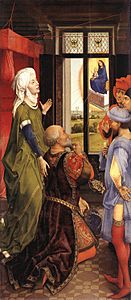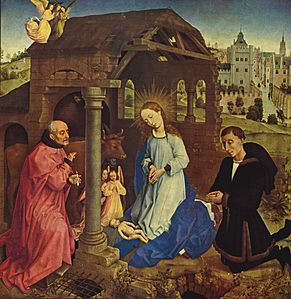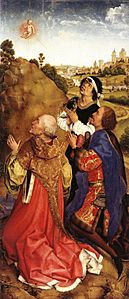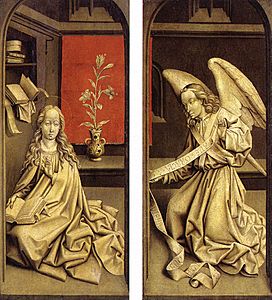Bladelin Altarpiece facts for kids
|
|
The Bladelin Altarpiece, also known as the Middelburg Altarpiece, is a special kind of painting called a triptych. A triptych is a painting made of three panels joined together. This artwork was created around 1450 by a famous Flemish painter named Rogier van der Weyden. He made it near the end of his career.
This painting shows different scenes about the birth of Jesus. It's the only painting of the Nativity that we know for sure was made by van der Weyden. Because of this, it's also called the Nativity Triptych. The altarpiece was given to a new church in the town of Middelburg in 1460. It might have been a gift from Pieter Bladelin, who helped start the town. Today, you can see this painting in the Gemäldegalerie, Berlin, where it has been since 1834.
Contents
What is the Bladelin Altarpiece?
The Bladelin Altarpiece is a large painting with three parts. It tells a story using pictures. The middle part is the biggest. The two side parts are smaller and can be closed like doors. When the doors are closed, you see different pictures on the outside.
The Main Painting: Birth of Jesus
The large middle panel shows the birth of Jesus. You can see Mary and baby Jesus in a stable in Bethlehem. There are animals and angels around them. The stable looks like an old, partly ruined stone building. It has arched windows and a tall stone pillar.
Three adults are kneeling and worshiping the baby Jesus. Mary is wearing a blue dress and cloak. To her left, Joseph holds a lit candle. On the right, a man in black clothes is kneeling outside the stable. This man is probably Pieter Bladelin, who gave the painting to the church.
In the background, on the left, you can see a tiny scene. An angel is telling shepherds about Jesus's birth. On the right, there's a city with roads, walls, and towers.
Side Panels: Other Important Stories
The two smaller side panels show other stories connected to the birth of Jesus.
Left Panel: Emperor Augustus's Vision
The left panel shows a story about the Roman Emperor Augustus. He asked a wise woman called the Tiburtine Sibyl if he was the greatest man on Earth. The Sibyl showed him a vision of the Virgin Mary and baby Jesus. After this, Augustus supposedly built an altar in Rome. It was dedicated to the "firstborn of God."
In the painting, the emperor is kneeling next to the Sibyl. He is looking towards the middle panel. He sees the vision through a window. This window has a double-headed eagle symbol. Three of Augustus's helpers stand nearby. They are wearing clothes from the 15th century.
Right Panel: The Magi Arrive
The right panel shows the three Magi arriving in Bethlehem. They are carrying gifts for baby Jesus. They are also kneeling and looking towards the central panel. They are seeing a vision of the infant Christ Child.
Outside Panels: The Annunciation
The side panels of the altarpiece were usually closed. They were only opened for church services on weekends or special days. When closed, the outside surfaces showed a painting in gray tones. This painting was of the Annunciation. This is the moment when the Angel Gabriel tells the Virgin Mary that she will have a baby.
On the left outside panel, Mary is shown with a red curtain. There is also a vase with a symbolic lily. On the right, the Angel Gabriel holds a scroll. It has the words "AVE GRAZIA PLENA" on it. This means "Hail [Mary] full of grace."
So, this triptych actually shows four Annunciation scenes. One is to Mary on the outside. The other three are inside: one to Augustus, one to the Magi, and one to the shepherds.
Size of the Painting
The middle panel of the altarpiece is about 93.5 centimeters (about 37 inches) tall and 92 centimeters (about 36 inches) wide. The left panel is 93.5 centimeters tall and 41.8 centimeters (about 16.5 inches) wide. The right panel is just a little smaller, at 93.5 centimeters tall and 41.5 centimeters (about 16.3 inches) wide.
Who Commissioned the Altarpiece?
The painting was likely given by Pieter Bladelin (around 1410-1472). He was the treasurer for Philip the Good, who was the Duke of Burgundy. Bladelin probably gave the altarpiece to the new church of Saints Peter and Paul in Middelburg, Flanders.
Pieter Bladelin founded the town of Middelburg in 1450. He worked hard to build it up. A French bishop named Jean Chevrot officially opened the church in 1460.
There is only one person shown in the painting who might be the donor. It's the man in black clothes with a fur-trimmed cloak. Usually, if Bladelin was the donor, his wife, Margerite van de Vageviere, would also be in the painting. This makes some people wonder if he was truly the only donor. The castle in the middle panel is thought to be the one in Middelburg.
The Bladelin Altarpiece has been part of the collection at the Gemäldegalerie, Berlin, since 1834.
See also
 In Spanish: Retablo Bladelin para niños
In Spanish: Retablo Bladelin para niños





